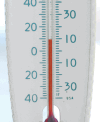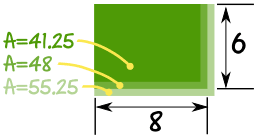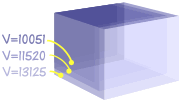what is the greatest possible error when measuring to the nearest quarter of an inch? in. in. in
Errors in Measurement
 | Mistake? No ... you didn't measure it incorrect ... this is almost accurateness. |
Measuring instruments are not verbal!
Degree of Accuracy
Accurateness depends on the instrument yous are measuring with. But as a general rule:
The degree of accurateness is half a unit each side of the unit of measurement of measure
Examples:
Notice that the arrow points to the same spot, but the measured values are different!
Plus or Minus
| We tin can bear witness the error using the "Plus or Minus" sign: | ± |
| When the value could be between 6½ and 7½: 7 ±0.5 The error is ±0.5 |  |
| When the value could be between 7 and 9: 8 ±1 The fault is ±1 |  |

Example: a fence is measured every bit 12.5 meters long, authentic to 0.i of a meter
Accurate to 0.i m means it could be up to 0.05 k either way:
Length = 12.5 ±0.05 m
So it could actually be anywhere betwixt 12.45 thousand and 12.55 m long.
Absolute, Relative and Percent Fault
The Absolute Error is the difference between the actual and measured value.
But ... when measuring we don't know the actual value! And then we utilize the maximum possible error.
In the case above the Absolute Error is 0.05 thousand
What happened to the ± ... ? Well, we just want the size (the accented value) of the deviation.
The Relative Error is the Absolute Error divided by the actual measurement.
We don't know the actual measurement, so the all-time we can do is use the measured value:
Relative Error = Absolute Fault Measured Value
The Percentage Error is the Relative Error shown every bit a percent (meet Pct Error).
Allow us run into them in an instance:

Example: fence (continued)
Length = 12.5 ±0.05 g
And then:
Absolute Fault = 0.05 1000
And:
Relative Error = 0.05 yard 12.5 m = 0.004
And:
Percentage Error = 0.four%
More examples:

Example: The thermometer measures to the nearest 2 degrees. The temperature was measured every bit 38° C
The temperature could exist up to 1° either side of 38° (i.east. between 37° and 39°)
Temperature = 38 ±1°
So:
Absolute Mistake = 1°
And:
Relative Error = 1° 38° = 0.0263...
And:
Pct Fault = 2.63...%
Example: You measure out the plant to be lxxx cm high (to the nearest cm)
This means you could be up to 0.5 cm wrong (the plant could be between 79.5 and fourscore.5 cm high)
Height = 80 ±0.5 cm
And then:
Absolute Fault = 0.5 cm
And:
Relative Error = 0.5 cm lxxx cm = 0.00625
And:
Percentage Error = 0.625%
Surface area
When working out areas yous need to think about both the width and length ... they could possibly both be the smallest measure or both the largest.
Example: Alex measured the field to the nearest meter, and got a width of vi m and a length of viii g.
Measuring to the nearest meter means the true value could be upwards to half a meter smaller or larger.

The width (w) could be from five.5m to vi.5m:
5.5 ≤ w < 6.5
The length (l) could exist from 7.5m to 8.5m:
seven.five ≤ l < eight.5
The area is width × length:
A = west × l
The smallest possible area is: 5.5m × 7.5m = 41.25 grandtwo
The measured area is: 6m × 8m = 48 g2
And the largest possible surface area is: 6.5m × viii.5m = 55.25 m2
41.25 ≤ A < 55.25
Absolute, Relative and Percent Error
The only catchy thing hither is ... which is the accented mistake?
- From 41.25 to 48 = 6.75
- From 48 to 55.25 = 7.25
Answer: selection the biggest one! So:
Absolute Mistake = seven.25 grand2
Relative Error = 7.25 mii 48 one thousand2 = 0.151...
Pct Error = 15.1%
(Which is not very authentic, is it?)
Volume
And book has 3 measurements: width, length and summit!
Each measurement could possibly exist the smallest possible measure, or the largest.
Instance: Sam measured the box to the nearest ii cm, and got 24 cm × 24 cm × xx cm
Measuring to the nearest two cm means the truthful value could exist up to 1 cm smaller or larger.
The three measurements are:
- 24 ±1 cm
- 24 ±one cm
- 20 ±1 cm
Volume is width × length × height:
V = w × 50 × h
The smallest possible Book is: 23cm × 23cm × 19cm = 10051 cmiii
The measured Volume is: 24cm × 24cm × 20cm = 11520 cm3
The largest possible Book is: 25cm × 25cm × 21cm = 13125 cm3

And then we get:
10051 ≤ V < 13125
Accented, Relative and Percentage Error
Accented error:
- From 10051 to 11520 = 1469
- From 11520 to 13125 = 1605
Pick the biggest i:
Absolute Error = 1605 cmiii
Relative Error = 1605 cmthree 11520 cm3 = 0.139...
Percentage Error = xiii.ix%
Source: https://www.mathsisfun.com/measure/error-measurement.html
Post a Comment for "what is the greatest possible error when measuring to the nearest quarter of an inch? in. in. in"